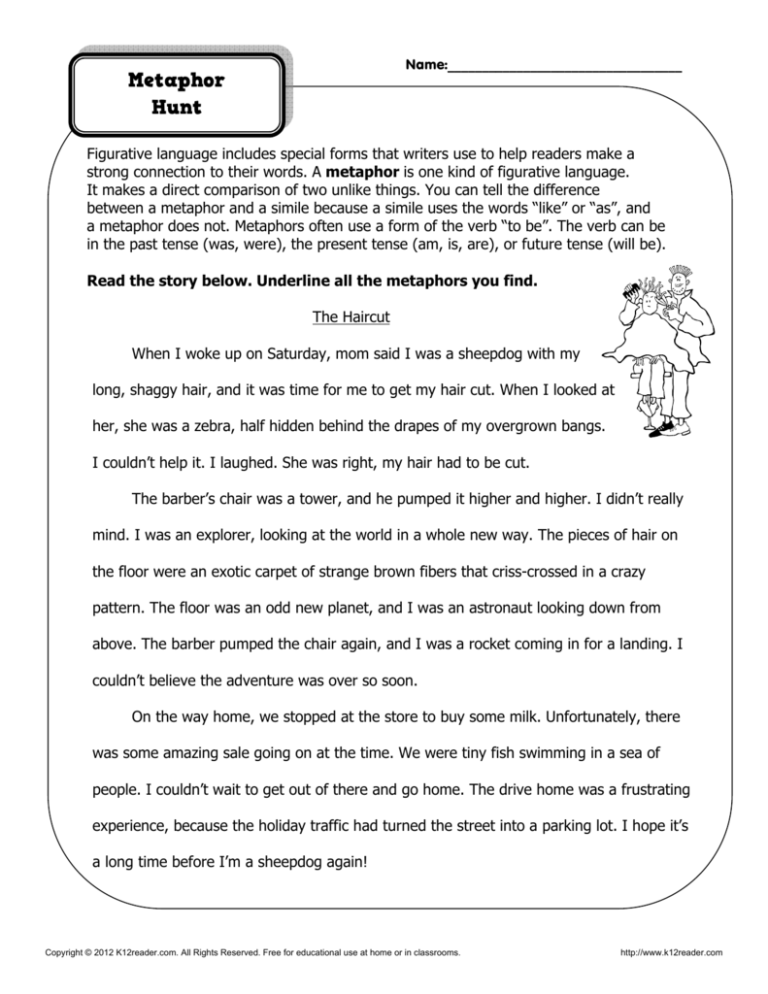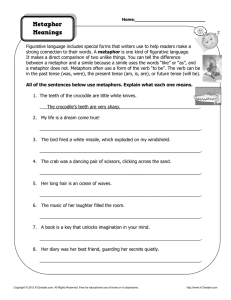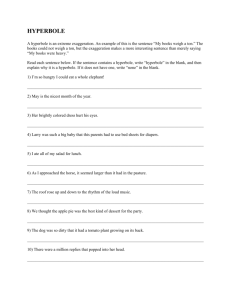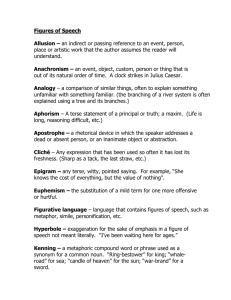
Name:__________________________________
Metaphor
Hunt
Figurative language includes special forms that writers use to help readers make a
strong connection to their words. A metaphor is one kind of figurative language.
It makes a direct comparison of two unlike things. You can tell the difference
between a metaphor and a simile because a simile uses the words “like” or “as”, and
a metaphor does not. Metaphors often use a form of the verb “to be”. The verb can be
in the past tense (was, were), the present tense (am, is, are), or future tense (will be).
Read the story below. Underline all the metaphors you find.
The Haircut
When I woke up on Saturday, mom said I was a sheepdog with my
long, shaggy hair, and it was time for me to get my hair cut. When I looked at
her, she was a zebra, half hidden behind the drapes of my overgrown bangs.
I couldn’t help it. I laughed. She was right, my hair had to be cut.
The barber’s chair was a tower, and he pumped it higher and higher. I didn’t really
mind. I was an explorer, looking at the world in a whole new way. The pieces of hair on
the floor were an exotic carpet of strange brown fibers that criss-crossed in a crazy
pattern. The floor was an odd new planet, and I was an astronaut looking down from
above. The barber pumped the chair again, and I was a rocket coming in for a landing. I
couldn’t believe the adventure was over so soon.
On the way home, we stopped at the store to buy some milk. Unfortunately, there
was some amazing sale going on at the time. We were tiny fish swimming in a sea of
people. I couldn’t wait to get out of there and go home. The drive home was a frustrating
experience, because the holiday traffic had turned the street into a parking lot. I hope it’s
a long time before I’m a sheepdog again!
Copyright © 2012 K12reader.com. All Rights Reserved. Free for educational use at home or in classrooms.
http://www.k12reader.com
Key
Name:__________________________________
Metaphor
Hunt
Figurative language includes special forms that writers use to help readers make a
strong connection to their words. A metaphor is one kind of figurative language.
It makes a direct comparison of two unlike things. You can tell the difference
between a metaphor and a simile because a simile uses the words “like” or “as”, and
a metaphor does not. Metaphors often use a form of the verb “to be”. The verb can be
in the past tense (was, were), the present tense (am, is, are), or future tense (will be).
Read the story below. Underline all the metaphors you find.
The Haircut
When I woke up on Saturday, mom said I was a sheepdog with my
long, shaggy hair, and it was time for me to get my hair cut. When I looked at
her, she was a zebra, half hidden behind the drapes of my overgrown bangs.
I couldn’t help it. I laughed. She was right, my hair had to be cut.
The barber’s chair was a tower, and he pumped it higher and higher. I didn’t really
mind. I was an explorer, looking at the world in a whole new way. The pieces of hair on
the floor were an exotic carpet of strange brown fibers that criss-crossed in a crazy
pattern. The floor was an odd new planet, and I was an astronaut looking down from
above. The barber pumped the chair again, and I was a rocket coming in for a landing. I
couldn’t believe the adventure was over so soon.
On the way home, we stopped at the store to buy some milk. Unfortunately, there
was some amazing sale going on at the time. We were tiny fish swimming in a sea of
people. I couldn’t wait to get out of there and go home. The drive home was a frustrating
experience, because the holiday traffic had turned the street into a parking lot. I hope it’s
a long time before I’m a sheepdog again!
Copyright © 2012 K12reader.com. All Rights Reserved. Free for educational use at home or in classrooms.
http://www.k12reader.com








